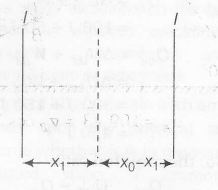Answer:
Option D
Explanation:
$B_{2}=\frac{\mu_{0}I}{2\pi x_{1}}+\frac{\mu_{0}I}{2\pi(x_{0}-x_{1})}$
{ when currents are in opposite directions)
$B_{1}=\frac{\mu_{0}I}{2\pi x_{1}}-\frac{\mu_{0}I}{2\pi(x_{0}-x_{1})}$

(when currents are in same direction)
Subtituting $x_{1}=\frac{x_{0}}{3}$ as \left(\frac{x_{0}}{x_{1}}\right)
$B_{1}=\frac{3\mu_{0}I}{2\pi x_{0}}-\frac{3\mu_{0}I}{4\pi x_{0}}=\frac{3\mu_{0}I}{4\pi x_{0}}$
$R_{1}=\frac{mv}{qB_{1}} $ and $ B_{2}= \frac{9\mu_{0}I}{4\pi x_{0}}$
$R_{2}=\frac{mv}{qB_{2}} $
$\frac{R_{1}}{R_{2}}=\frac{B_{2}}{B_{1}}=\frac{9}{3}=3$